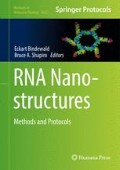Abstract
Human immunodeficiency virus Type 1 (HIV-1) is the major cause of acquired immune deficiency syndrome (AIDS). In 2014, it was estimated that 1.2 million people died from AIDS-related illnesses. RNA interference-based therapy to block HIV replication is a field that, as of now, is without any FDA-approved drugs available for clinical use. In this chapter we describe a protocol for testing and utilizing a new approach that relies on reassociation of RNA–DNA hybrids activating RNAi and blocking HIV replication in human cells.
Access this chapter
Tax calculation will be finalised at checkout
Purchases are for personal use only
References
Bramsen JB, Kjems J (2012) Development of therapeutic-grade small interfering RNAs by chemical engineering. Front Genet 3:154
Fire A, Xu S, Montgomery MK et al (1998) Potent and specific genetic interference by double-stranded RNA in Caenorhabditis elegans. Nature 391(6669):806–811
Parrish S, Fleenor J, Xu S et al (2000) Functional anatomy of a dsRNA trigger: differential requirement for the two trigger strands in RNA interference. Mol Cell 6(5):1077–1087
Lund E, Dahlberg JE (2006) Substrate selectivity of exportin 5 and Dicer in the biogenesis of microRNAs. Cold Spring Harb Symp Quant Biol 71:59–66
Ji X (2008) The mechanism of RNase III action: how dicer dices. Curr Top Microbiol Immunol 320:99–116
Macrae IJ, Zhou K, Li F et al (2006) Structural basis for double-stranded RNA processing by Dicer. Science 311(5758):195–198. doi:10.1126/science.1121638
Dao BN, Viard M, Martins AN et al (2015) Triggering RNAi with multifunctional RNA nanoparticles and their delivery. DNA RNA Nanotechnol 1(1):27–38
Schwarz DS, Hutvagner G, Du T et al (2003) Asymmetry in the assembly of the RNAi enzyme complex. Cell 115(2):199–208
Khvorova A, Reynolds A, Jayasena SD (2003) Functional siRNAs and miRNAs exhibit strand bias. Cell 115(2):209–216
Pratt AJ, MacRae IJ (2009) The RNA-induced silencing complex: a versatile gene-silencing machine. J Biol Chem 284(27):17897–17901
Afonin KA, Viard M, Martins AN et al (2013) Activation of different split functionalities on re-association of RNA-DNA hybrids. Nat Nanotechnol 8(4):296–304
Shekhawat SS, Ghosh I (2011) Split-protein systems: beyond binary protein-protein interactions. Curr Opin Chem Biol 15(6):789–797
Rose SD, Kim DH, Amarzguioui M et al (2005) Functional polarity is introduced by Dicer processing of short substrate RNAs. Nucleic Acids Res 33(13):4140–4156
Afonin KA, Viard M, Tedbury P et al (2016) The use of minimal RNA toeholds to trigger the activation of multiple functionalities. Nano Lett 16(3):1746–1753
Afonin KA, Desai R, Viard M et al (2014) Co-transcriptional production of RNA-DNA hybrids for simultaneous release of multiple split functionalities. Nucleic Acids Res 42(3):2085–2097
Afonin KA, Bindewald E, Kireeva M et al (2015) Computational and experimental studies of reassociating RNA/DNA hybrids containing split functionalities. Methods Enzymol 553:313–334
Afonin KA, Grabow WW, Walker FM et al (2011) Design and self-assembly of siRNA-functionalized RNA nanoparticles for use in automated nanomedicine. Nat Protoc 6(12):2022–2034
Grabow WW, Zakrevsky P, Afonin KA et al (2011) Self-assembling RNA nanorings based on RNAI/II inverse kissing complexes. Nano Lett 11(2):878–887
Yingling YG, Shapiro BA (2007) Computational design of an RNA hexagonal nanoring and an RNA nanotube. Nano Lett 7(8):2328–2334
Afonin KA, Bindewald E, Yaghoubian AJ et al (2010) In vitro assembly of cubic RNA-based scaffolds designed in silico. Nat Nanotechnol 5(9):676–682
Afonin KA, Kasprzak W, Bindewald E et al (2014) Computational and experimental characterization of RNA cubic nanoscaffolds. Methods 67(2):256–265
Afonin KA, Viard M, Kagiampakis I et al (2015) Triggering of RNA interference with RNA-RNA, RNA-DNA, and DNA-RNA nanoparticles. ACS Nano 9(1):251–259
Afonin KA, Viard M, Koyfman AY et al (2014) Multifunctional RNA nanoparticles. Nano Lett 14(10):5662–5671
Rogers TA, Andrews GE, Jaeger L et al (2015) Fluorescent monitoring of RNA assembly and processing using the split-spinach aptamer. ACS Synth Biol 4(2):162–166
Groves B, Chen YJ, Zurla C et al (2016) Computing in mammalian cells with nucleic acid strand exchange. Nat Nanotechnol 11(3):287–294
Low JT, Knoepfel SA, Watts JM et al (2012) SHAPE-directed discovery of potent shRNA inhibitors of HIV-1. Mol Ther 20(4):820–828
Adachi A, Gendelman HE, Koenig S et al (1986) Production of acquired immunodeficiency syndrome-associated retrovirus in human and nonhuman cells transfected with an infectious molecular clone. J Virol 59(2):284–291
Waheed AA, Ono A, Freed EO (2009) Methods for the study of HIV-1 assembly. Methods Mol Biol 485:163–184
Author information
Authors and Affiliations
Corresponding author
Editor information
Editors and Affiliations
Rights and permissions
Copyright information
© 2017 Springer Science+Business Media LLC
About this protocol
Cite this protocol
Martins, A.N. et al. (2017). Intracellular Reassociation of RNA–DNA Hybrids that Activates RNAi in HIV-Infected Cells. In: Bindewald, E., Shapiro, B. (eds) RNA Nanostructures . Methods in Molecular Biology, vol 1632. Humana Press, New York, NY. https://doi.org/10.1007/978-1-4939-7138-1_18
Download citation
DOI: https://doi.org/10.1007/978-1-4939-7138-1_18
Published:
Publisher Name: Humana Press, New York, NY
Print ISBN: 978-1-4939-7137-4
Online ISBN: 978-1-4939-7138-1
eBook Packages: Springer Protocols

